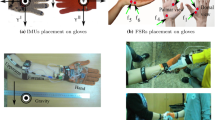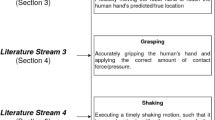Abstract
Hand-raising is a way of expressing the intention or communication. The authors are going to create a communication field where people can express their intention freely. This study evaluates impressions of hand-raising motions for communication participants.
You have full access to this open access chapter, Download conference paper PDF
Similar content being viewed by others
Keywords
1 Introduction
Hand-raising is a motion that represents an active participation in classroom learning, and it is very important for learners to raise their hand in the classroom [1, 2]. Nevertheless, not all learners can actively raise a hand but it is thought to be important to promote learners’ to raise their hands in classroom [3].
The authors proposed the concept of a communication enhancement system which is shown in Fig. 1. This system measures learners’ actions using cameras and other sensors and promotes learners to raise hand by giving appropriate feedback based on measured data, using embodied media technology, such as Computer Graphic (CG) characters or robots.
However, there is a huge problem in building this system. The hand-raising motions suitable for feedback are not known. This is because hand-raising motions have not been focused on in academic studies; perhaps, psychological factors of hand raising were studied in an educational area [1, 2].
The purpose of this study is to reveal relations between typical motions of hand-raising and their impressions. In this study, impressions of hand raising motions are evaluated in two situations—single character situation and classroom situation, as described in the next section.
2 Method
In the analysis of this study, hand-raising motions of CG characters are used as targets of impression evaluation as they can reproduce motions exactly. The authors extracted five typical motions of hand-raising using motion capture technology and cluster analysis [4]. These motions are converted into these for CG characters from motion captured data, as shown in Fig. 2 and Table 1 and used for this study.
Motions A and B are fast and high motions, motion B being the highest and fastest one. Motions D and E are slow and low motions, motion E being the lowest and slowest one. Motion C is in the middle position.
In this study, impressions of hand raising motions are evaluated through two experiments. In the first experiment, each hand-raising motion of CG characters is evaluated when a character raises a motion (single character situation). The first experiment is conducted to reveal motions’ impressions mainly for someone who watches and picks hand-raising learners.
In the second experiment, these motions are evaluated in a situation in which some CG characters raise their hands at the same time (classroom situation). The second experiment is conducted to reveal motions’ impressions mainly for learners who raise hand by themselves.
3 Impression Evaluation of Hand-Raising Motions of a Single Character
3.1 Purpose and Method
The purpose of the experiment is to measure impressions of hand-raising motions in a situation wherein each motion is raised by only one character. Impressions of hand-raising motions are then evaluated.
CG characters are projected on a screen by using a projector (EPSON EB-1735W) and five motions are reproduced, as shown in Fig. 2. Participants of the experiment show and evaluate them.
The experiment has two sub situations. The first is normalized-rank approach, shown in Fig. 3. Participants watch five CG characters at the same time, and each of them reproduces a different motion, as shown in Fig. 2. Participants compare these motions in three aspects. Participants are twenty people aged between 19 and 24 years (ten males and ten females).
The second is paired-comparison, as shown in Fig. 4. Participants watch two characters in each trial and reproduce two different motions, as shown in Fig. 2. All pairs of motions are compared through this situation. Participants are twenty people aged between 21 and 24 years (ten males and ten females).
3.2 Results and Discussion
Results of the normalized rank approach analysis are shown in Fig. 5. Participants evaluate and compare motions in the three aspects shown at the bottom of Fig. 5. The three aspects are “Arrange motions in the order of good impression”, “Arrange motions in the order you feel like picking” and “Arrange motions in the order he/she seems to be picked”.
In Fig. 5, the right side denotes that a participant has agreed to an item. For example, motion A in item I has the best impression. From results, motions A and B are highly evaluated in all three aspects while motion C is moderately evaluated. Whereas, motions D and E have relatively bad impression. To summarize, high hand-raising motions are highly valued in giving a good impression or activeness in representation of intention.
Next, participants answer four questions in paired-comparison; “Choose more impressive one”, “Choose more confident one”, “Choose more active one” and “Choose one which looks like doing her best”. Thurstone’s paired comparison is conducted and results are summarized using Bradeley-Terrymodel [5], as shown in Fig. 6. The height of blue bars depicts the “strength” of motions. The higher the blue bar, higher is a more rated in paired-comparison.
In all four questions, motions A and B are highly evaluated. In addition, motion A wins to motion B in question 2, however, motion B wins to motion A in question 3.
Results of normalized-rank approach and paired-comparison conclude that high and fast motions have relatively good impressions. The results of paired-comparison show that effects of speed and height is not linear. Motion B being the fastest and the highest still loses to Motion A in question 3 in Fig. 6. This fact shows that impressive hand-raising is not the same as active hand-raising. When the authors make embodied media, as shown in Fig. 1, suitable speed and height of hand-raising media depends on its objective.
4 Impression Evaluation of Hand-Raising Motions in Classroom Situation
4.1 Purpose and Method
The purpose of the second experiment is to reveal motions’ impressions mainly for learners who raise their hand by themselves, in a classroom-like situation where many other learners exist around.
In the experiment, the scene of a classroom and fifty-five CG characters are projected on a screen, as shown in Fig. 7. Participants are explained that they are in a classroom with a teacher asking for a comment. They are requested to evaluate impressions for each scene in the five aspects described later.
Each CG character raises the hand in motion B or E, which are the same as motions used in the first experiment described in Chap. 3. This is because motion B is represents good-impression motions while motion E represents bad-impression motions. In addition, the number of characters that reproduce each motion is thought to be a factor of impressions in this situation and then two situations are set; when all the characters raise their hands in the same motion and when only five characters raise their hands in the same motion.
To summarize, there are four situations; (a) all characters raise their hands in motion A (High-All), (b) all characters raise their hands in motion E (Low-All), (c) Only five characters raise their hands in motion A (High-Five), and (d) only five characters raise their hands in motion E (Low-Five), as shown in Fig. 7.
Participants are twenty people aged between 21 and 24 years old (ten females and ten males).
4.2 Results and Discussion
In the experiment, five aspects are considered on a 7-point scale. Results are analyzed using Wilcoxon signed-rank test and Bonferroni method. These five aspects are (1) “I feel active atmosphere”, (2) “classroom is animated,” (3) “everyone look confident”, (4) “I feel be easy to raise hand” and (5) “I feel that I have to raise hand”. Results of the analysis and the considered aspects are shown in Fig. 8.
In results of questions 1 and 2, there are significant differences except for comparison between (b) Low-All and (c) High-Five. In results of question 3, all pairs have significant differences. In results of question 4, comparisons between (a) High-All and (d) Low-Five, and between (a) Low-All and (d) Low-Five show significant differences. In results of question 5, almost all pairs show significant differences.
Results of the experiment imply that high hand-raising and homogeneity (all learners act as the same) of the classroom are important to build good impressions generally. Nevertheless, there are some minor differences between questions.
In questions 1 and 2, which are about impression of a whole classroom, effects of hand-raising and homogeneity are similar. In question 3, which is about confidence, it is important to raise hand in high and fast motion or slow and low motion, but homogeneity is relatively, not important. However, in questions 4 and 5, which are about promoting effect for hand-raising, homogeneity is very important while height and speed are not so important comparatively.
5 Summary
In this study, some impressions of typical hand-raising motions are evaluated through two experiments; each motion is reproduced by a single CG character or groups of CG characters raise hand being surrounded by a participant. According to the results of experiments, high and fast hand-raising generally gives a good impression. In addition, there are some implications from results.
For impressions for the watcher of hand-raising, if hand-raising which looks active is needed, very fast (about 4710 mm/s) motion is suitable. If hand-raising which looks confident is needed, moderately fast (about 2806 mm/s) motion is suitable.
In the classroom situation, if promotion of hand-raising is required, homogeneity of classroom members’ action is very important. However, if the atmosphere of classroom is focused on, speed and height of hand-raising are suitable for intervention.
This study revealed relations between motions and impressions of hand-raising. Implications are limited to classroom situation; however, it is thought to be useful to implement the concept of communication enhancement by raising-hand media shown in Fig. 1.
References
Fuju, H.: A study on the relationships between kyosyu (hand raising), self-efficacy, outcome-expectancy and outcome-value (in Japanese). Jpn. J. Educ. Psychol. 29(1), 92–101 (1991)
Fuse, M., Kodaira, H., Ando, F.: Positive class participation by elementary school pupils: motivation and differences in grade and gender (in Japanese). Jpn. J. Educ. Psychol. 5(4), 534–545 (2006)
Hirata, M., Chibana, Y.: A study on pupils’ self expression in through their active participation in an element classroom -developing a recognition scale of self expression- (in Japanese). Bull. Fac. Educ. Univ. Ryukyus 83, 67–99 (2013)
Aoyagi, S., Kawabe, R., Yamamoto, M., Watanabe, T.: Hand-raising robot for promoting active participation in classrooms. In: Yamamoto, S., de Oliveira, N.P. (eds.) HIMI 2015. LNCS, vol. 9173, pp. 275–284. Springer, Heidelberg (2015). doi:10.1007/978-3-319-20618-9_27
Hirotsu, C.: A goodness of fit test for the Bradley-Terry model by a multiple comparisons approach (in Japanese). Qual. Jpn. Soc. Qual. Control 13(2), 141–149 (1983)
Author information
Authors and Affiliations
Corresponding author
Editor information
Editors and Affiliations
Rights and permissions
Copyright information
© 2016 Springer International Publishing Switzerland
About this paper
Cite this paper
Aoyagi, S., Yamamoto, M., Fukumori, S. (2016). Analysis of Hand Raising Actions for Group Interaction Enhancement. In: Yamamoto, S. (eds) Human Interface and the Management of Information: Information, Design and Interaction. HIMI 2016. Lecture Notes in Computer Science(), vol 9734. Springer, Cham. https://doi.org/10.1007/978-3-319-40349-6_30
Download citation
DOI: https://doi.org/10.1007/978-3-319-40349-6_30
Published:
Publisher Name: Springer, Cham
Print ISBN: 978-3-319-40348-9
Online ISBN: 978-3-319-40349-6
eBook Packages: Computer ScienceComputer Science (R0)












